271 results
1 - Introduction to Intellectual Property
-
- Book:
- A Critical Introduction to Intellectual Property Law
- Published online:
- 17 May 2024
- Print publication:
- 06 June 2024, pp 1-14
-
- Chapter
- Export citation
Chapter 10 - Being and Existence in the Consolation of Philosophy
-
-
- Book:
- Boethius’ ‘Consolation of Philosophy’
- Published online:
- 23 May 2024
- Print publication:
- 30 May 2024, pp 169-185
-
- Chapter
- Export citation
Chapter 7 - Concepts and Universals in Aristotle’s Metaphysical Thought
-
-
- Book:
- Conceptualising Concepts in Greek Philosophy
- Published online:
- 25 April 2024
- Print publication:
- 02 May 2024, pp 147-177
-
- Chapter
- Export citation
3 - Nietzsche’s Centaurs
-
-
- Book:
- Nietzsche and Literary Studies
- Published online:
- 03 May 2024
- Print publication:
- 25 April 2024, pp 59-90
-
- Chapter
- Export citation
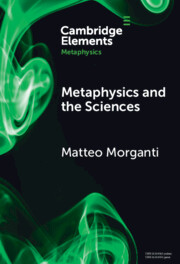
Metaphysics and the Sciences
-
- Published online:
- 22 April 2024
- Print publication:
- 30 May 2024
-
- Element
- Export citation
Chapter 42 - The Wagnerian Erotics of Video Game Music
- from VI - Reception
-
-
- Book:
- Wagner in Context
- Published online:
- 14 March 2024
- Print publication:
- 14 March 2024, pp 421-431
-
- Chapter
- Export citation
Chapter 10 - Nietzsche and Wagner: The Logic of Contradiction
- from II - People
-
-
- Book:
- Wagner in Context
- Published online:
- 14 March 2024
- Print publication:
- 14 March 2024, pp 104-112
-
- Chapter
- Export citation
The Metaphysics of Meaning: Aquinas and the Meaning of Life
-
- Journal:
- New Blackfriars ,
- Published online by Cambridge University Press:
- 01 March 2024, pp. 1-15
-
- Article
-
- You have access
- Open access
- HTML
- Export citation
Public Reason Requirements in Bioethical Discourse
-
- Journal:
- Cambridge Quarterly of Healthcare Ethics , First View
- Published online by Cambridge University Press:
- 23 February 2024, pp. 1-10
-
- Article
-
- You have access
- Open access
- HTML
- Export citation
Chapter 2 - Carnap Is Not against Metaphysics
- from Part I - Philosophy in New Dress
-
-
- Book:
- Interpreting Carnap
- Published online:
- 01 February 2024
- Print publication:
- 08 February 2024, pp 32-49
-
- Chapter
- Export citation
Chapter 3 - Interpreting Carnap’s Construction of the World
- from Part I - Philosophy in New Dress
-
-
- Book:
- Interpreting Carnap
- Published online:
- 01 February 2024
- Print publication:
- 08 February 2024, pp 50-69
-
- Chapter
- Export citation
7 - John Buridan on the Ontological Status of Artifacts
-
-
- Book:
- Interpreting Buridan
- Published online:
- 01 February 2024
- Print publication:
- 08 February 2024, pp 101-134
-
- Chapter
- Export citation
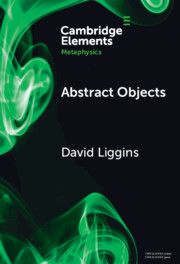
Abstract Objects
-
- Published online:
- 05 February 2024
- Print publication:
- 29 February 2024
-
- Element
-
- You have access
- HTML
- Export citation
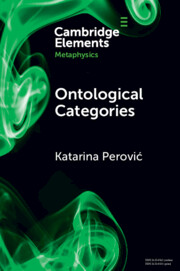
Ontological Categories
- A Methodological Guide
-
- Published online:
- 31 January 2024
- Print publication:
- 29 February 2024
-
- Element
- Export citation
Comments on Gabriele Gava, Kant’s Critique of Pure Reason and the Method of Metaphysics
-
- Journal:
- Kantian Review / Volume 29 / Issue 1 / March 2024
- Published online by Cambridge University Press:
- 22 January 2024, pp. 125-133
- Print publication:
- March 2024
-
- Article
-
- You have access
- Open access
- HTML
- Export citation
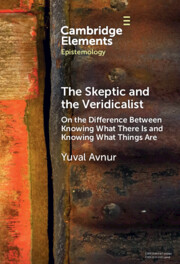
The Skeptic and the Veridicalist
- On the Difference Between Knowing What There Is and Knowing What Things Are
-
- Published online:
- 18 December 2023
- Print publication:
- 18 January 2024
-
- Element
- Export citation
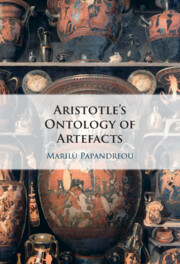
Aristotle's Ontology of Artefacts
-
- Published online:
- 14 December 2023
- Print publication:
- 21 December 2023
Chapter 6 - The Artist Is Not Present
-
-
- Book:
- Kierkegaard's <i>Either/Or</i>
- Published online:
- 16 November 2023
- Print publication:
- 30 November 2023, pp 98-115
-
- Chapter
- Export citation
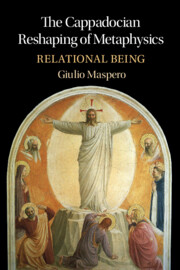
The Cappadocian Reshaping of Metaphysics
- Relational Being
-
- Published online:
- 11 January 2024
- Print publication:
- 09 November 2023
Chapter 6 - Form, Matter, and Metaphysics in Walter Pater’s Essay on ‘Style’
- from Part I - General
-
-
- Book:
- Walter Pater and the Beginnings of English Studies
- Published online:
- 14 November 2023
- Print publication:
- 09 November 2023, pp 118-132
-
- Chapter
- Export citation



